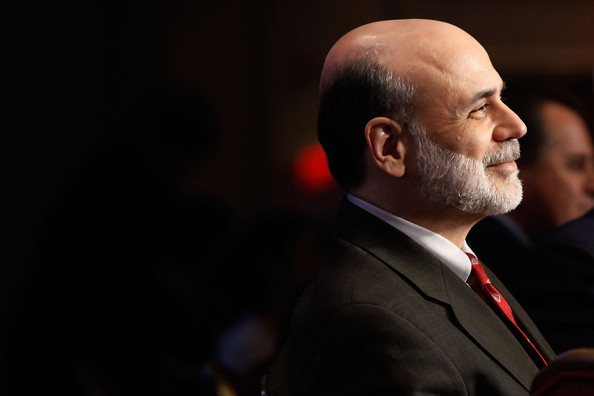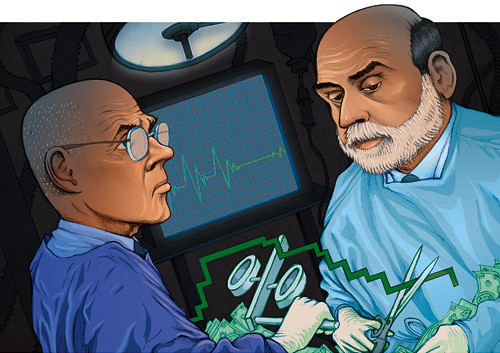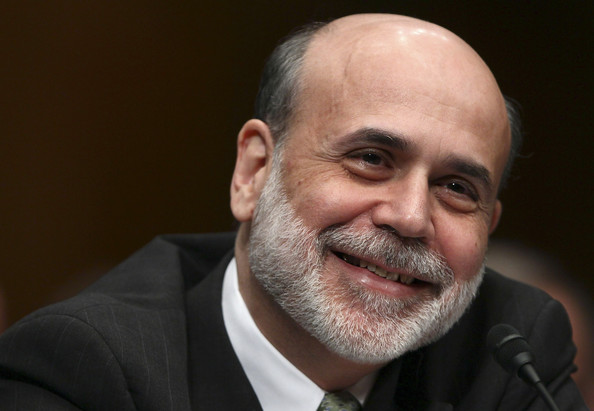MUST READ: Some Bailout Questions FED Czar ‘Bernanke The Magnificent’ STILL Hasn’t Answered (Beatdown)
Courtesy of The Daily Bail


Why were bank bondholders made whole, while taxpayers got shafted? That’s the most important question of all, yet no one has ever asked him.
—
Two exceptional editorials from the WSJ earlier this week. Reprinted with permission.
On the key facts behind the bailouts of 2008, regulators have stonewalled the public, the press and even the inspector general of the Troubled Asset Relief Program. On Wednesday, we’ll find out if they can also stonewall the Financial Crisis Inquiry Commission.
Chairman Phil Angelides and his panel will begin two days of hearings on the subject of "Too Big to Fail," featuring testimony from Federal Reserve Chairman Ben Bernanke and Federal Deposit Insurance Corporation Chairman Sheila Bair. Across bailouts from Bear Stearns to AIG, the government has refused to release its analysis of the "systemic risks" that compelled it to mount unprecedented interventions into the financial system with taxpayer money. Two years after the crisis, Mr. Angelides and his colleagues should finally let the sun shine on this critical period of our economic history.
A year ago we told you about former FDIC official Vern McKinley, who has made a series of Freedom of Information Act requests. He wanted to know what Fed governors meant when they said a Bear Stearns failure would cause a "contagion." This term was used in the minutes of the Fed meeting at which the central bank discussed plans by the Federal Reserve Bank of New York to finance Bear’s sale to J.P. Morgan Chase. The minutes contained no detail on how exactly the fall of Bear would destroy America.
He also requested minutes of the FDIC board meeting at which regulators approved financing for a Citigroup takeover of Wachovia. To provide this assistance, the board had to invoke the "systemic risk" exception in the Federal Deposit Insurance Act, and it therefore had to assert that such assistance was necessary for the health of the financial system. Yet days later, Wachovia cut a better deal to sell itself to Wells Fargo, instead of Citi. So how necessary was the assistance?
The regulators have been giving Mr. McKinley the Heisman, but two weeks ago federal Judge Ellen Segal Huvelle made the FDIC show her the Wachovia documents. She is still considering the McKinley suit, but the crisis commission doesn’t need to wait for her decision. It should let all Americans read them now.
Then there’s AIG. Who decided that firm was too big to fail, and on what basis? Last winter, Senator Jim Bunning went on CNBC and said that Mr. Bernanke’s staff did not think AIG was too big to fail. "His staff didn’t agree with him. . . . I’m talking about an email that he sent his staff after his staff recommended that the Federal Reserve not touch AIG," said Mr. Bunning.
In February, we sent a FOIA request to the Fed for an internal memo entitled "Issues Related to Possible IPC Lending to American International Group" and an email from Chairman Bernanke that included a draft of the proposal that he would soon present to the Fed Board of Governors to approve lending to AIG. Yesterday a Fed spokeswoman told us it is still reviewing the request.
You could argue that the Fed has been a model of good government in handling our request compared to the way it has responded to TARP inspector general Neil Barofsky. Documents he’s asked for were not produced and in some cases the New York Fed has told Mr. Barofsky that documents did not exist when in fact they did. Along with investigating the management of the crisis, the former prosecutor is also now investigating the withholding of information about the crisis.
What could the New York Fed be hiding? For one thing, a clear explanation of why it felt it had to bail out AIG. The story from regulators during the crisis was that credit-default swap counterparties had to be paid lest the financial system collapse. The public became incensed about 100-cents on the dollar pay-outs to big banks. Then last winter, Treasury Secretary Timothy Geithner, who ran the New York Fed in 2008, said the real problem had been AIG’s insurance business, threatening average consumers.
Writing in our pages in February, former New York Insurance Superintendent Eric Dinallo said that "policyholders would have been protected" in the event of an AIG bankruptcy. That seemed clear enough, but then Mr. Dinallo immediately added that an AIG bankruptcy "would have been bad for those same policyholders." So which was it? State insurance regulators and industry analysts have since told us that Mr. Dinallo was wrong when he suggested that policyholders would have suffered.
Two years after the bailouts and more than a month after President Obama signed into law new authority for the government to prevent "systemic risk," Washington still won’t tell us what this term means. Releasing the history of 2008 would at least allow us to know what regulators thought it meant at the time, with lessons for the future. Is there any other reason for this inquiry commission to exist?
****
After two more days of hearings this week about the 2008 credit meltdown, the lid on Federal Reserve Chairman Ben Bernanke’s black box remains shut and locked. Testifying Thursday before the Financial Crisis Inquiry Commission, Mr. Bernanke made clearer than ever that financial "systemic risk" is whatever he and his fellow regulators decide it is. Read on and weep at how little has changed despite financial "reform."
The danger of a systemic financial failure was the government’s catch-all justification for its unprecedented market interventions beginning with Bear Stearns in March 2008. Asked by commissioner Keith Hennessey this week to define "systemic risk,"Mr. Bernanke said that many academics are currently trying to do just that, but there remains a debate about how to measure it. Taxpayers might hope that Mr. Bernanke would demand a clear definition before he commits the nexttrillion dollars, but that’s probably not the way to bet. The Fed Chairman confidently predicted that determining the level of such risk will largely "remain subjective."
As bad as this news is for taxpayers, the potentially worse news came when Mr. Hennessey asked if, in times of crisis, the government could still assist a particular company now that Dodd-Frank reform is the law of the land. Mr. Bernanke quickly put the matter to rest by noting that a too-big-to-fail company undergoing the government’s new resolution process could still receive money from the Treasury. Uh, oh.
As for what particular risk at AIG inspired Mr. Bernanke to authorize a taxpayer bailout that grew to $182 billion, Mr. Bernanke’s answer was vague, but it differed from the explanation offered by Treasury Secretary Timothy Geithner.
Mr. Geithner has testified that an AIG bankruptcy would have threatened the insurance subsidiaries on which consumers rely. Mr. Bernanke apparently knew better than to try that one on commissioner Brooksley Born, whose mission in life is to blame the crisis on over-the-counter derivatives, especially credit-default swaps. Ms. Born asked if AIG was considered a systemic risk "in part because many of the world’s largest and most important financial firms were AIG’s counterparties on these credit default swaps, and thus could have been impacted with AIG’s failure."
Mr. Bernanke danced around the question. After all, who wants to argue that we had to use tax dollars to bail out French banks and Goldman Sachs? The Fed chairman artfully suggested that while the AIG counterparties didn’t all necessarily need the help, the risk would be triggered by the "uncertainty" among investors wondering which ones needed help and which ones didn’t. Mr. Bernanke added that at the time of the rescue in September 2008 and even now, two years later, he never learned the net exposure of the giant banks to AIG.
More plausibly, he described the potential downside for creditors with "commercial paper, corporate bonds and other vehicles" that "would have triggered an intensification of the general run on international banking institutions." Mr. Bernanke made no mention of the AIG insurance businesses.
So it appears the Geithner explanation for the AIG bailout is no longer operable, and Mr. Bernanke has now confirmed that his own decision was based on intuition, not a study of credit exposures. We imagine Johnny Carson holding an envelope to his head as Carnac the Magnificent, as Ed McMahon (Hank Paulson) intones, "you, in your divine and mystical way, will ascertain the answers having never before seen the questions."
But did Mr. Bernanke’s staff perform such a risk study, which he ignored? On Thursday the Fed told us it is still reviewing our Freedom of Information Act request for a staff recommendation to Mr. Bernanke. Senator Jim Bunning has said he’s seen evidence showing that the Fed staff opposed the bailout. The crisis commission should release this document, along with Mr. Bernanke’s subsequent email with the draft proposal to the Fed Board of Governors to approve lending to AIG.
This week the commission did at least release the minutes of the September 2008 meeting at which the FDIC board approved a "systemic risk" exception to allow the government to finance the sale of Wachovia Bank to Citigroup. Wells Fargo later topped Citi’s bid in a private transaction, showing that federal assistance wasn’t necessary.
The minutes reveal that while the staff did see a systemic risk, the FDIC was under intense pressure from the Fed and Treasury to approve the deal. FDIC Chairman Sheila Bair noted that she only acquiesced after Treasury agreed to cover any FDIC losses as they occurred, without waiting, as is customary, for the Federal Deposit Insurance Fund to be depleted before providing assistance.
***
Which brings us to the most troubling part of Mr. Bernanke’s testimony. While reciting a litany of mistakes by private firms and various harms allegedly caused by a lack of regulation, the Fed chief once again dismissed the notion that loose Fed monetary policy contributed to the credit bubble.
So there you have it: The chairman takes no responsibility for the monetary roots of the credit mania but wants virtually unbridled authority to intervene in the markets based on a hip-pocket judgment about "systemic risks" that not even he can define. Taxpayers will just have to take his word for it.



